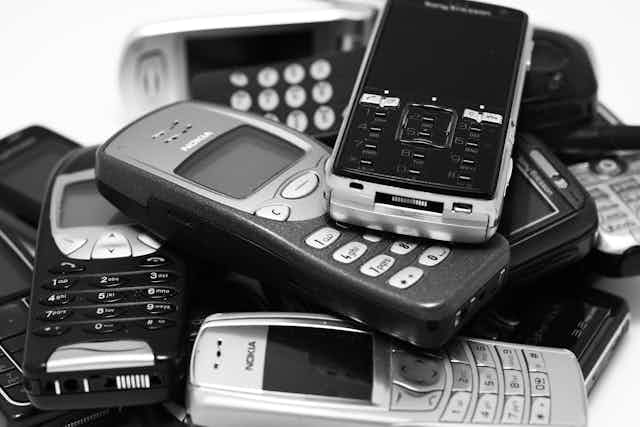In Australia there are many more mobile services in use than there are people.
The majority of Australians upgrade or exchange their mobile phones every 18 to 24 months, while an increasing number have owned their mobile for more than two years. The upshot is that there is around 22.5 million unwanted mobiles cluttering up homes around Australia.
And many of these mobiles incorporate components using elements from across the periodic table, including many rare and valuable ones, such as gold. On average, there will be a total of one gram of gold across 41 mobile phones. In other words, about 1 metric tonne of smartphone handsets could yield 340g of gold, which on current gold prices is more than A$18,000.
So if we’re smart, we should be extracting as much value as possible from these disused smartphones through recycling.
What goes around…
There are several services around Australia that can recycle your mobile phone and prevent it going to landfill, including Clean Up Australia, Youth Cancer, which is run by Sony, and Aussie Recycling Program (ARP).
The largest service is MobileMuster, which is a free not-for-profit product stewardship program of the Australian mobile phone industry and has been running since 1998.
MobileMuster uses the recycler TES-AMM’s process, which includes six steps, including separating out various types of batteries, and recovering precious metals from circuit boards.
More than 90% of the materials used in mobile phones are recyclable and can be reused to make things like stainless steel goods, new batteries or plastic fence posts.
New approaches for collecting mobile phones in Australia are now being tested and implemented, such as Telstra’s eCycle program. This program, which is supported by MobileMuster and is free until March 2016, arranges for couriers to collect boxes full of electronic waste (e-waste), including mobile phones, for recycling.

The mining connection
Collection and transport logistics are a key part of the mobile phone recycling value chain. But current best practice for the actual process of mobile phone recycling is still a combination of semi-automated and manual extraction processes. The most difficult of these is the separation process.
One idea that we have been exploring is applying the expertise and technologies from the very beginning of the metals value chain right to the end of that chain.
The mining industry has vast expertise in metallurgical, mineral and chemical processing techniques, and use these to extract minerals and metals from ore. The mining industry uses technology that can cost effectively mine large volumes of rock, moving over a million tonnes a day in some large mines.
It can also process high rates of ore at low grades, in some cases, several thousand tonnes per hour, to produce mineral concentrate ready for smelting, and if necessary, further refining to pure metal.
We think these approaches could be modified, adapted or honed to efficiently collect mobile phone from urban areas. They could then use automated techniques to separate the valuable components of mobile phones for metals recovery.
At present, the total amount of metals in old mobile phones is only a fraction of the metals in minerals ore bodies around the world. But the worldwide trend of increasing e-waste is pushing the metals recycling industry from a medium scale scale to one treating a “bulk commodity” e-waste, with similarities to the extraction of metals from mined ore bodies.
For the time being, the best thing to do with your old mobile phone is donate it to a service such as Mobile Muster or Telstra’s eCycle program. That way, toxic materials can be removed and valuable metals might remain in circulation rather than being consigned to the tip.

